So, what exactly are eco-friendly cleaning products? At their core, they are cleaning solutions made from plant-derived, biodegradable ingredients. They also come in sustainable packaging, offering an effective way to clean your home without causing harm to the environment. Think of it as a conscious move away from harsh, synthetic chemicals towards a healthier, greener way of life.
The Shift to Green Cleaning in Your Home
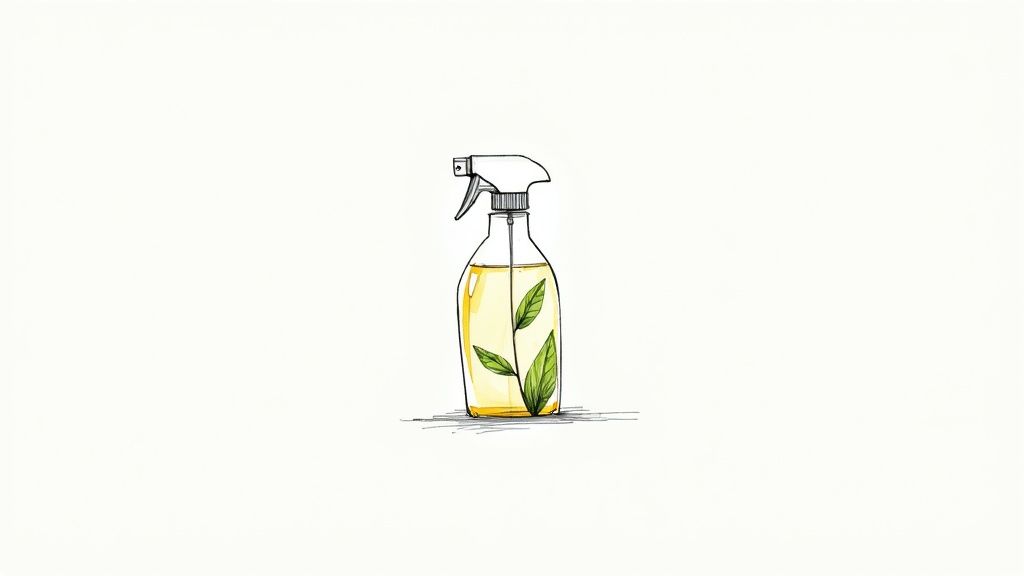
Choosing green cleaning solutions isn’t a niche interest anymore; it’s becoming a mainstream approach to household chores. For families across the UK, this change is sparked by a growing awareness of what’s actually inside conventional cleaners and how those ingredients might affect our health and the planet.
This isn’t just a passing trend. It’s a real response to genuine concerns about indoor air quality, the damage chemical runoff does to our local waterways, and the mountains of single-use plastic waste from traditional cleaning supplies.
Why Households Are Making the Switch
The reasons for this shift are often quite personal. Many of us are simply looking for ways to create a safer space for our children and pets, free from the strong fumes and chemical residues that many standard products leave behind. This kind of conscious consumer choice is really starting to reshape the entire cleaning industry.
You can see this change reflected in the market. The UK’s natural household cleaners segment was valued at around USD 678.7 million in 2024 and is expected to nearly double by 2030. It’s a clear signal that people want products that are both effective and kind to the environment. You can learn more about the growth of the natural cleaners market and the trends driving it.
By choosing eco-friendly cleaning products, you are not just cleaning your home. You are casting a vote for a healthier planet, safer living spaces, and a more sustainable future for everyone.
It’s amazing how such a simple switch can have such a big ripple effect. When you opt for a biodegradable all-purpose spray or a plant-based laundry detergent, you’re supporting a wider movement. Each purchase backs companies committed to ethical sourcing, smaller carbon footprints, and genuinely earth-friendly solutions.
So, what’s really pushing this transition?
- Improved Health and Wellbeing: Cutting down on exposure to volatile organic compounds (VOCs) and allergens found in many conventional cleaners means better indoor air quality and fewer respiratory irritations.
- Environmental Protection: Biodegradable formulas break down safely in the environment, which stops toxic chemicals from polluting our rivers and harming aquatic life.
- Sustainable Packaging: A lot of eco-friendly brands are championing refillable containers, recycled materials, and plastic-free options, tackling the packaging waste problem head-on.
Ultimately, bringing green cleaning into your home is about realising that the small choices we make every day can add up to a huge positive impact. It’s a practical, powerful way to make our daily routines reflect our values.
How to Read Labels and Avoid Greenwashing
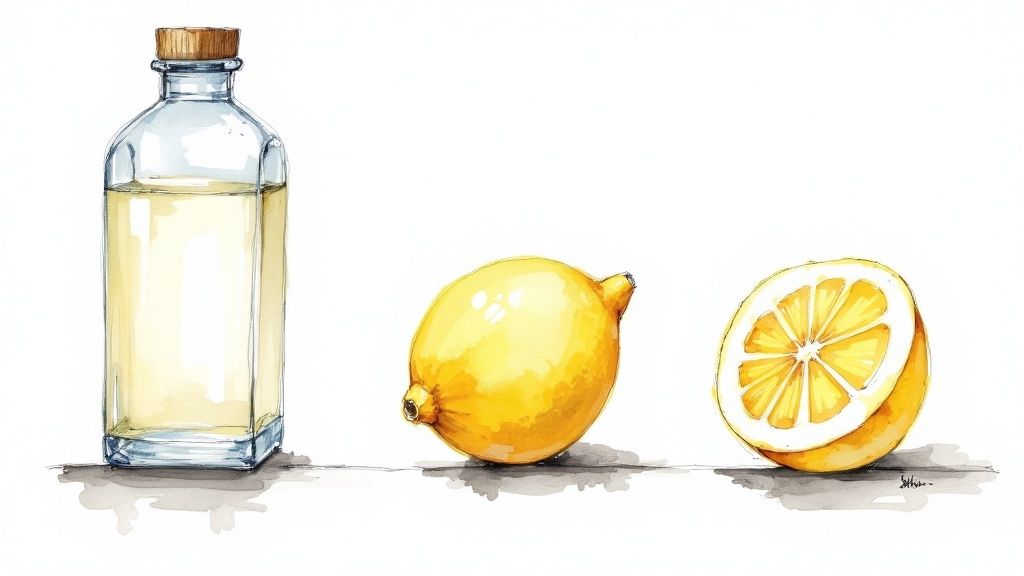
Walking down the cleaning aisle can feel overwhelming. You’re hit with a barrage of buzzwords—‘natural’, ‘green’, ‘eco’—plastered across every bottle. But what do these labels really mean? Learning to read them properly is your best defence against marketing tricks.
It’s an important skill to have, because not all “green” claims are genuine. Some bottles represent a real commitment to sustainability, while others are just marketing fluff. This practice is known as greenwashing, and spotting the difference empowers you to make choices that are genuinely better for your home and the planet.
Decoding Common Eco-Friendly Terms
To become a more informed shopper, it helps to get to grips with the language you’ll find on the packaging. Let’s break down a few of the most common terms.
Think of a biodegradable product like an apple core you’d toss in a compost bin. Microorganisms will naturally break it down into simple elements like water and carbon dioxide, leaving nothing harmful behind. In contrast, a conventional cleaner is more like a plastic bottle; it can stick around for hundreds of years, causing potential harm to wildlife and ecosystems.
Another term you’ll see everywhere is non-toxic. At its core, this just means the product isn’t expected to cause harm or illness when you use it as intended. While that’s great, it’s a very broad claim. Always look for a clear ingredient list to back it up.
Finally, sustainably sourced tells you about where the raw materials came from. It’s a promise that the ingredients were harvested in a way that doesn’t drain our natural resources and minimises damage to the environment.
The Trap of Greenwashing
So, what is greenwashing? It’s when a company puts more effort and money into appearing environmentally friendly than it does into actually being environmentally friendly. It often relies on vague, unproven claims to mislead well-intentioned customers.
Greenwashing preys on our desire to do the right thing. It uses earthy colours, nature-themed packaging, and feel-good words without any real proof, making it tough to separate genuine eco-friendly cleaning products from clever imitations.
The easiest way to spot it is to look for vague claims that lack detail. Phrases like “earth-friendly” or “all-natural” are red flags if they aren’t supported by a certification or a full list of ingredients. Genuinely green brands are transparent and proud of what goes into their bottles.
Trustworthy Certifications to Look For
Third-party certifications are your most reliable guide. When you see one of these logos, it means an independent organisation has checked the product against strict environmental and performance standards. They cut right through the marketing noise.
Here’s a quick guide to some of the most common and trustworthy certifications you’ll find on products sold here in the UK.
Common Eco-Friendly Certifications and What They Mean
| Certification Logo/Name | What It Guarantees | Commonly Found On |
|---|---|---|
| EU Ecolabel (The Flower Logo) | The product has a reduced environmental impact throughout its entire life cycle, from sourcing to disposal. | All-purpose cleaners, laundry detergents, and dishwashing liquids. |
| Ecocert | Guarantees that at least 95% of ingredients are from natural origins and are processed in an eco-friendly way. | Natural detergents, surface sprays, and organic home care products. |
| Cruelty-Free International (Leaping Bunny) | The gold standard for animal welfare, confirming no animal testing occurred at any stage of product development. | A wide range of cleaning products, from bathroom cleaners to air fresheners. |
These logos are a fantastic shortcut to making a good choice, but their absence doesn’t automatically mean a product is bad. Smaller, local companies might not have the budget for official certification but still operate with high ethical standards. In that case, look for clear ingredient lists and a company mission you can get behind.
Of course, choosing products that actually work is just as important—after all, a powerful cleaner saves you from dealing with tougher jobs later. For advice on those really tricky messes, our guide on how to remove stubborn stains might come in handy. By arming yourself with label knowledge, you can confidently choose the best eco-friendly cleaning products for your home.
The Real Benefits of Making the Switch
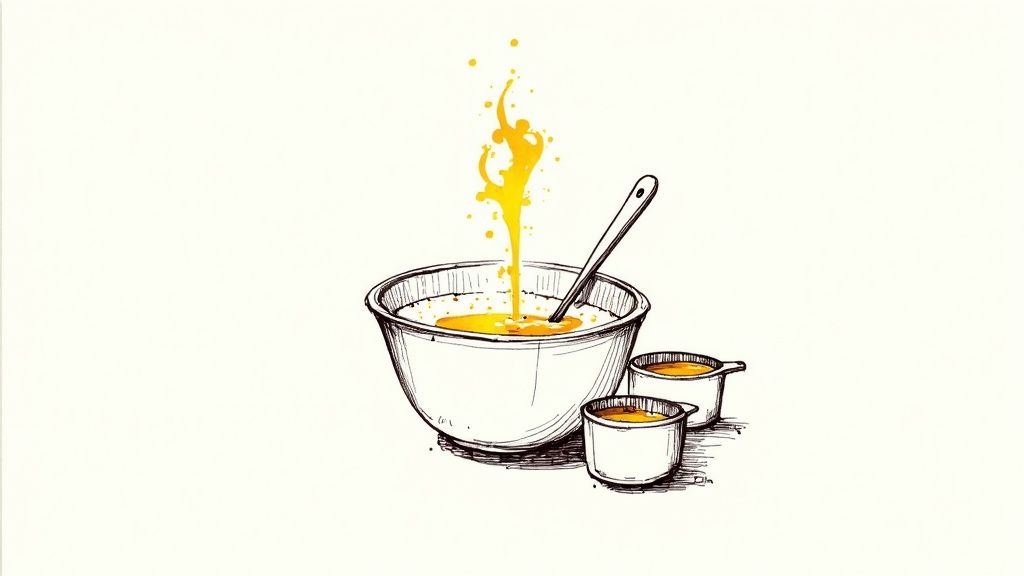
Choosing eco-friendly cleaning products goes far beyond just a good feeling. It brings tangible, practical benefits to your home, your family’s health, and the wider environment. This isn’t some abstract concept; the positive changes begin the moment you swap a conventional cleaner for a plant-based one, setting off a chain reaction that reaches well beyond your front door.
Take a moment to think about the air inside your home. Many standard cleaners are packed with Volatile Organic Compounds (VOCs), which are chemicals that turn into gases at room temperature. Every time you spray that bleach-based bathroom cleaner or a strong air freshener, these VOCs hang in the air, creating that all-too-familiar harsh chemical smell and potentially irritating your lungs.
A Healthier Home Environment
Making the switch to eco-friendly options can seriously improve your indoor air quality. These products are generally made without harsh solvents, ammonia, or chlorine bleach, which immediately cuts down on the airborne nasties floating around your living space. This is a game-changer for households with young children, pets, or anyone dealing with allergies or asthma.
For them, a cleaner home environment can mean fewer triggers and simply breathing easier. It’s a small change that helps turn your home into a true sanctuary.
This move toward greener, healthier alternatives is really shaking up the market. In the UK, the household cleaners sector, which includes eco-friendly laundry and surface cleaners, is expected to pull in revenues of around US$1.60 billion in 2025. This isn’t a fluke; it’s driven by everyday people demanding products that work without compromising on safety or sustainability. You can explore more about these UK household cleaner market trends on Statista.com.
So, what does this mean for you?
- For Your Family: Less exposure to potentially harsh chemicals, which can reduce the risk of skin irritation and respiratory issues.
- For Your Home: Fresher indoor air and no chemical residues left on the surfaces where kids and pets eat and play.
Protecting Our Waterways and Wildlife
The story doesn’t end once you’ve wiped down the counters. When a conventional cleaner goes down the drain, its non-biodegradable chemicals enter the water system. Things like phosphates and aggressive surfactants are tough for water treatment plants to filter out completely.
Sooner or later, these chemicals can find their way into our rivers and oceans. Phosphates, for instance, act like a super-fertiliser for algae, causing massive blooms that suck all the oxygen out of the water. This process, called eutrophication, creates “dead zones” where fish and other aquatic life simply can’t survive.
Choosing a biodegradable cleaner is like giving nature a helping hand. Its ingredients are designed to break down harmlessly into simple elements, just like a fallen leaf on a forest floor, leaving no toxic trace behind.
This simple decision helps protect fragile aquatic ecosystems. Every time you choose plant-based eco friendly cleaning products, you are actively stopping harmful pollutants from poisoning our shared environment. It’s about making sure our cleaning routines help the planet, not harm it.
By making this conscious switch, you’re doing more than just cleaning your home. You’re taking a real, practical step towards protecting the natural world for years to come. The positive effects are clear, both inside your walls and out in the wider world, proving that small choices can add up to big, lasting change.
Understanding Powerful Plant-Based Ingredients
The secret to truly effective eco-friendly cleaning isn’t some complex chemical formula; it’s all about the ingredients. Instead of relying on harsh, lab-made synthetics, these products tap into the power of plants and minerals to get the job done. It’s like switching from a pharmacist to an apothecary—you’re using nature’s own toolkit to achieve a sparkling clean.
This isn’t about sacrificing strength for safety. It’s about smart science that combines traditional wisdom with modern know-how to create formulas that are both gentle and genuinely effective against everyday dirt and grime.
Nature’s Cleaning Champions
So, what are these natural workhorses? You’d be surprised how many are probably sitting in your kitchen right now. Take simple white vinegar, for instance. Its natural acidity is fantastic for cutting through grease and breaking down mineral deposits like limescale. It just works.
Then there’s citric acid, which, as the name suggests, comes from citrus fruits like lemons. It’s a natural whizz at removing limescale and softening hard water because it binds to mineral ions, making them simple to wipe away. That’s why you’ll often find it in bathroom and kitchen cleaners, leaving taps gleaming without any harsh scrubbing.
The image below gives a great snapshot of why making this switch has such a positive ripple effect.
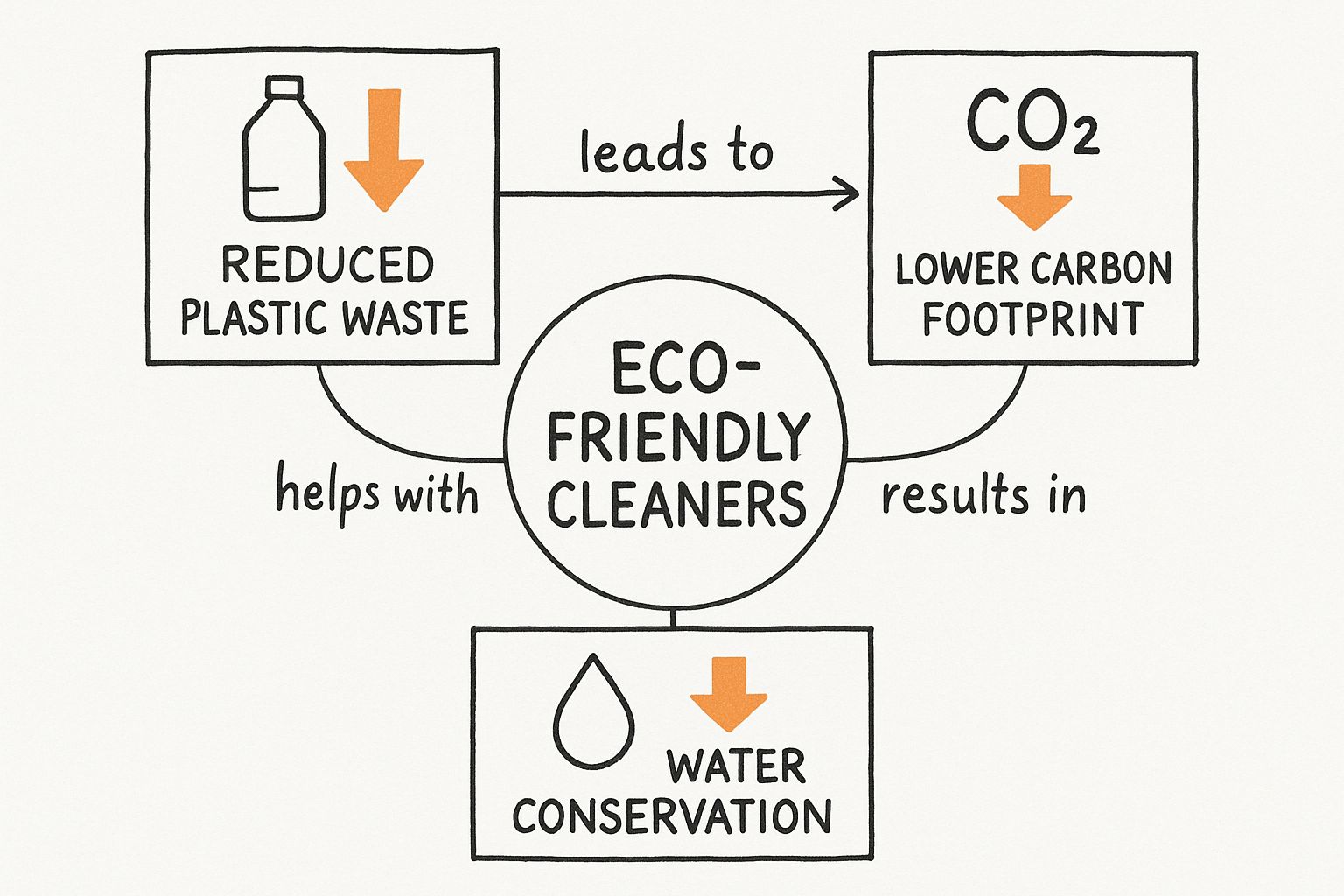
It really shows how choosing better ingredients directly helps the planet by reducing plastic waste, cutting carbon emissions, and conserving precious water.
The Science Behind the Suds
Every cleaner needs a surfactant—that’s the key ingredient that actually lifts dirt from a surface so it can be washed away. In conventional products, these are typically petroleum-based. Green cleaners, on the other hand, use plant-derived surfactants, often from coconuts, corn, or even sugar.
They function in the exact same way. Think of a surfactant molecule as a tiny magnet with two different ends: one end sticks to water, and the other sticks to dirt and oil. When you clean, these molecules surround the grime, pull it off the surface, and let the water rinse it all away. The crucial difference is that plant-based versions are biodegradable and much kinder to our waterways.
Essential oils also pull double duty. They’re not just in there for a lovely, natural scent. Many oils—like tea tree, lavender, and eucalyptus—have potent antibacterial and antifungal properties. This means they can gently disinfect surfaces, offering a much safer alternative to overpowering synthetic disinfectants.
The power of eco-friendly products isn’t a compromise. It comes from smartly applying the cleaning properties already found in nature. From acidic fruits to coconut-based soaps, these ingredients prove you don’t need harsh chemicals for a powerful clean.
To really see the difference, let’s compare some of these natural heroes with their conventional chemical counterparts. This side-by-side view makes it clear why so many are making the change.
Eco-Friendly Ingredients vs. Conventional Chemicals
This table breaks down how common eco-friendly ingredients stack up against the chemicals you’d find in traditional cleaners for the same jobs.
| Cleaning Task | Eco-Friendly Ingredient | Conventional Chemical | Key Difference |
|---|---|---|---|
| Degreasing | Plant-based surfactants (from coconuts/corn) | Petroleum-based surfactants | Derived from renewable resources and biodegrade safely, unlike petroleum which is a finite resource and can harm aquatic life. |
| Disinfecting | Tea tree oil or eucalyptus oil | Chlorine bleach or quaternary ammonium compounds | Provides natural antibacterial properties without the harsh fumes or corrosive effects of bleach, making it safer for indoor air. |
| Removing Limescale | Citric acid or acetic acid (vinegar) | Phosphoric acid or hydrochloric acid | Highly effective at dissolving mineral deposits but are far less corrosive and toxic, posing minimal risk to skin and surfaces. |
| General Scrubbing | Bicarbonate of soda (baking soda) | Abrasive powders with synthetic particles | Acts as a gentle, non-scratching abrasive that deodorises naturally and is completely biodegradable and food-safe. |
By getting to know these core ingredients, you can see that green cleaning is about choosing smarter, safer options that deliver brilliant results. It’s not about giving up on performance; it’s about protecting your home and the planet. This knowledge empowers you to pick your products with confidence, knowing exactly what makes them work so well.
Taking Green Cleaning Pro: A Guide for Cleaning Services
The move towards eco-friendly cleaning isn’t just happening in people’s homes; it’s a huge opportunity for professional cleaning services. For any cleaning business out there, going green is no longer a niche gimmick. It’s a savvy business decision that meets a growing demand from clients and gives you a real edge over the competition. This is about building a business that’s not just profitable, but also responsible and resilient.
And let’s be clear, this is about more than just marketing. Think about your own team. They’re the ones on the front line, working with cleaning chemicals day in and day out. Switching to non-toxic, plant-based formulas means less exposure to harsh fumes and skin irritants. That can lead to fewer sick days and a happier, healthier crew.
The Business Case for Going Green
Across the UK, the demand for sustainable services is really taking off. It’s not just residential clients, either. Big corporate sectors like healthcare and hospitality are increasingly required—or at least strongly encouraged—to use green-certified products. If you’re running a cleaning service, you can’t afford to ignore this shift.
The numbers back this up, too. The professional cleaning products market in the UK is expected to hit around USD 4.9 billion by 2033, growing at a rate of 12.9% a year from 2025. A massive chunk of that growth is being driven by the demand for sustainable options. You can discover more insights about the UK professional cleaning market to get the full picture.
When a cleaning company markets its services as ‘eco-friendly,’ it’s not just trying to attract a small group of eco-warriors. It’s about positioning the brand as a premium, forward-thinking provider that cares about health, safety, and the environment. These are qualities that more and more clients—both commercial and residential—are actively looking for and are often willing to pay more for.
Putting It Into Practice
Making the switch to green cleaning needs a solid plan. It’s not just a matter of swapping out a few bottles; it’s about weaving sustainability into the very fabric of your business operations.
Here are a few practical steps to get you started:
- Buy Smart: Find suppliers who can give you bulk discounts on certified eco-friendly products. Look for concentrated formulas and refillable systems—they’re a fantastic way to cut down on costs and slash your packaging waste at the same time.
- Train Your Team: Your staff are your biggest advocates. Give them proper training on how to use the new products, covering everything from the right dilution ratios for concentrates to which cleaners work best on which surfaces. Make sure they understand the health benefits for themselves, not just for the clients.
- Shout About It: Update your website, flyers, and social media to show off your commitment to green cleaning. Be clear about the benefits: a healthier office or home, better indoor air quality, and a smaller environmental footprint. Being transparent builds trust and helps you attract the right kind of customers.
- Explain the Value: When you’re quoting for a new job, don’t just list your prices. Explain why you use eco-friendly products. Frame it as part of the premium, responsible service you offer, not as an extra cost.
By making sustainability a core part of what you do, your business becomes more than just a cleaning service. You become a partner in creating healthier spaces for people to live and work.
Your Practical Plan for a Greener Home
Getting inspired to go green is one thing, but turning that spark of motivation into a lasting habit is where the real magic happens. The good news? Switching to eco-friendly cleaning products doesn’t have to be a massive, expensive project. It’s really just about taking small, smart steps that add up over time.
Think of it like learning any new skill. You wouldn’t expect to become an expert overnight. You start with the fundamentals and build from there. That same mindset is perfect for creating a cleaning routine that’s kinder to your family and the planet.
Start with a Single Swap
The simplest way to get started is to pick just one product to replace. There’s no need to raid your cupboards and throw everything out. Just wait until your current all-purpose cleaner or washing-up liquid is empty, then choose a plant-based, eco-friendly version to take its place. This “one-in, one-out” strategy is easy on the wallet and avoids unnecessary waste.
A multi-purpose cleaner is a fantastic first choice. Because you use it for so many different jobs around the house, making this one change can have a surprisingly big impact on your home’s chemical footprint straight away.
Adopting a greener cleaning routine is a journey, not a race. The goal is to build sustainable habits that last, and that starts with small, intentional changes you can stick with. Every single swap is a victory for your home and the planet.
This gradual approach makes the whole process feel less like a chore and more like a natural evolution. Before you know it, you’ll have built a full eco-friendly cleaning toolkit without feeling the strain.
Smart Strategies for a Greener Clean
Once you’ve made that first swap and feel comfortable, you can start weaving in a few other simple yet effective habits. These little changes not only help the environment but can often save you a bit of money, too.
Here are a few ideas to get you on your way:
- Choose Concentrates: Lots of eco-conscious brands now sell their cleaners in a concentrated form. You get a small bottle of the powerful stuff, which you then dilute with water at home. This seriously cuts down on packaging and transport emissions, and it’s usually cheaper in the long run.
- Embrace Refillable Options: Keep an eye out for local zero-waste shops or brands that sell refill pouches. By simply reusing your original spray bottle again and again, you can massively reduce your plastic waste. Just one refillable bottle can save dozens of single-use plastic bottles from ever reaching a landfill.
- Make Your Own: You’d be surprised what you can clean with basic ingredients you already have. A simple mix of equal parts white vinegar and water in a spray bottle is a brilliant, streak-free cleaner for glass and many other surfaces. Just remember to keep it away from natural stone like marble or granite
Your Green Cleaning Questions Answered
Diving into the world of eco-friendly cleaning naturally brings up a few questions. It’s completely normal to wonder if a plant-based spray can really tackle that stubborn grime on the hob, or whether going green will stretch your budget.
Let’s clear up some of the most common queries. Think of this as the final piece of the puzzle, giving you the confidence to make the switch for good.
Are Eco-Friendly Cleaners Actually as Good as the Chemical Stuff?
Yes, they absolutely are. Don’t let the gentle ingredients fool you; modern green cleaners are powerhouses. They’ve moved far beyond the simple vinegar-and-bicarb solutions of the past.
Today’s best formulas use clever plant-based science—things like citric acid, natural enzymes, and plant-derived surfactants—that are specifically designed to break down grease and kill germs just as well as their harsh chemical counterparts. The trick is to stick with trusted brands that have really invested in their research. You don’t have to compromise on a sparkling finish.
Will I End Up Spending More on Green Products?
It’s a common concern, but the answer is usually no, not in the long run. While the initial bottle might seem a bit pricier on the shelf, many eco-friendly cleaners are highly concentrated. This means you dilute them at home, so a single bottle lasts ages and the cost per clean plummets.
Plus, with the rise of refill stations and subscription services, you’re not constantly paying for new plastic bottles. When you add up the savings and factor in the benefits for your health and the planet, eco-friendly cleaning products quickly become the more sensible financial choice.
The true value of green cleaning isn’t just on the price tag. It’s in breathing cleaner air at home, cutting down on plastic waste, and the peace of mind you get from using products that are safe for your family and the planet.
Where’s the Best Place to Buy Green Cleaning Products in the UK?
Thankfully, it’s easier than ever. You can find fantastic options right in your local supermarket. Big names like Tesco, Sainsbury’s, and Waitrose all have dedicated sections with popular brands like Ecover and Method.
If you want to explore a bit more, health food shops like Holland & Barrett are a great bet. For refillables, check out your local zero-waste shop—they’re brilliant for reducing packaging. And for the biggest selection, online stores like The Ethical Superstore or Big Green Smile stock everything from big brands to smaller, independent gems.
Ready to enjoy a sparkling clean home without the harsh chemicals? Let the professionals at Signal Cleaning handle the hard work for you. Our expert team uses high-quality, effective cleaning methods to ensure your home is spotless. Book your professional home cleaning service in Oxford today.
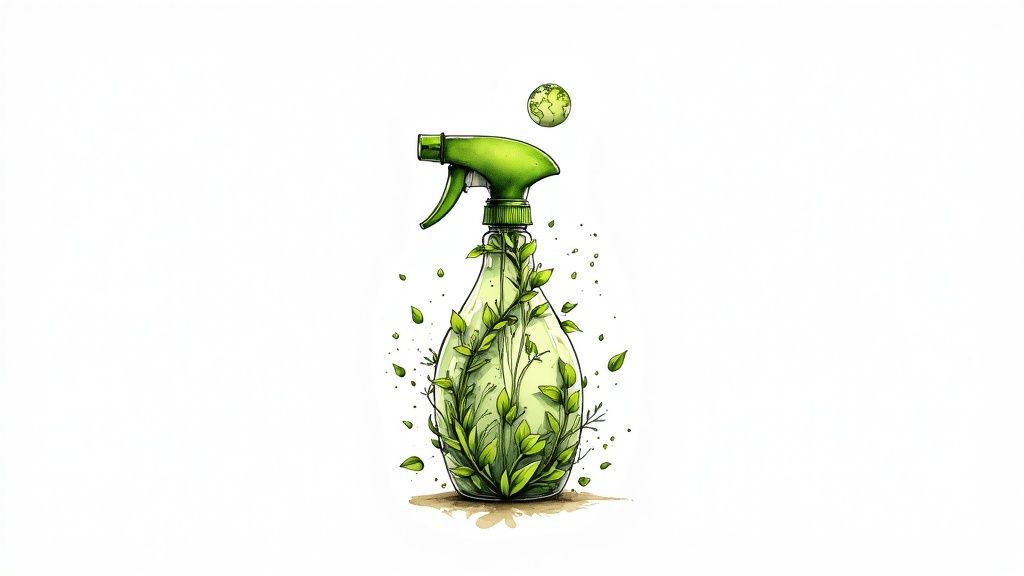
Leave a Reply